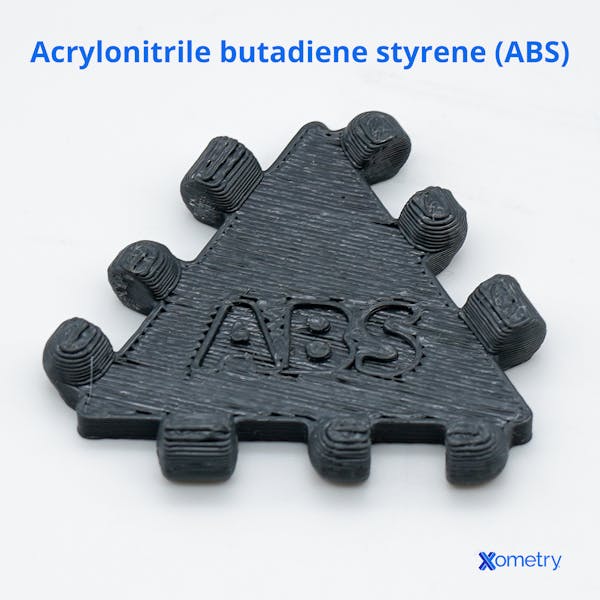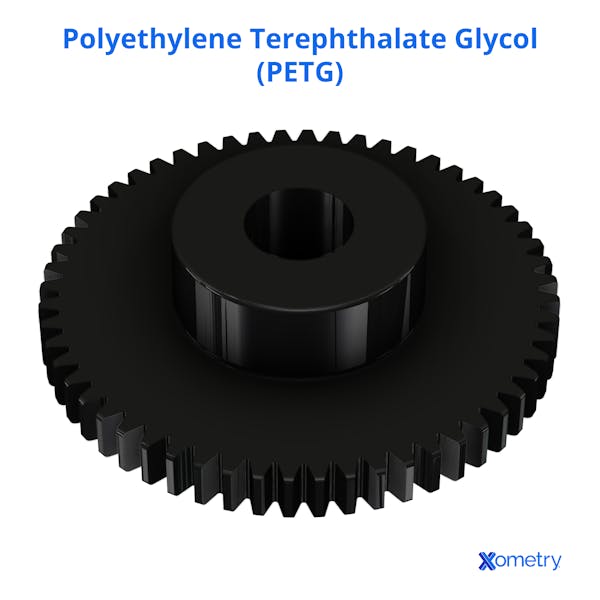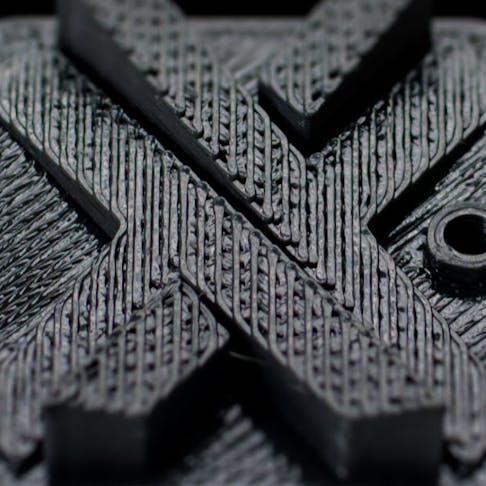Both acrylonitrile butadiene styrene (ABS) and polyethylene terephthalate glycol-modified (PETG) are thermoplastics used in 3D printing, often with high-temperature printers. They can both handle their fair share of stress and strain, can be recycled, and are both susceptible to moisture—although at differing degrees; one is far less hygroscopic than the other. Also, one deteriorates much quicker if left out, and one is a third of the price cheaper than the other. We won’t leave you in suspense any longer; read on to find out which is which.
ABS Definition and Comparison to PETG
As a styrene-acrylonitrile copolymer, ABS’s properties have been changed by the presence of butadiene rubber. It’s durable, thanks to the styrene, and its heat-, chemical-, and impact resistance can be credited to the butadiene. This also helps it keep its shape and toughness during processing. This multipurpose thermoplastic, which today is used a lot in additive manufacturing, dates back to the mid-1940s when it was used to make bullet-proof plastic sheets. It was later patented in 1948 and made commercially available by the Borg-Warner Corporation in 1954. The following image shows a part we made with ABS here at Xometry:

ABS responds quite well to post-processing; it can be painted, machined, and reworked, and is less susceptible to moisture in the air. It also works out to be rather cost-effective because it’s easily available and isn’t too pricey to produce. But, ABS does have certain drawbacks, too; it reacts negatively to UV radiation, is not very adhesive, and isn’t really resistant to chemicals.
What are the Advantages of ABS Compared to PETG?
Below are some advantages of ABS compared to PETG:
- ABS responds better to post-processing than PETG. It can be painted, machined, and reworked.
- The availability and low production cost of ABS make it more cost-effective compared to PETG.
- ABS is suitable for high-temperature applications. PETG starts to deform at bed temperatures of 80°C or more.
- ABS is less susceptible to moisture in the air than PETG. If PETG is not properly stored, it will deteriorate.
What are the Disadvantages of ABS Compared to PETG?
Below are some of the disadvantages of ABS compared to PETG:
- ABS reacts negatively to UV radiation. PETG, on the other hand, fares well in sunlight.
- ABS has poor adhesive properties compared to PETG.
- ABS is less resistant to chemical changes than PETG.
PETG Definition and Comparison to ABS
PETG is a pretty tough copolyester thermoplastic that was first made by modifying the glycol molecule found in polyethylene terephthalate (PET); PET is tough enough on its own, but once the glycol is modified, it becomes less brittle. It’s impact-, heat-, and humidity-resistant, and, with enough heat, can be molded into different shapes. Also, it’s not toxic, so it can be used to make things like transparent water bottles and products for the food industry. The image below shows a gear made from this material:

PETG fares quite well in alkaline and acidic environments and doesn’t warp as easily as ABS can. It’s also known as the best filament for making transparent items, and if you’ll be exposing it to UV light, that’s fine, too. The potential downsides of using PETG, though, are that it tends to be pricier than alternatives, like ABS, and can degrade over time if not stored properly because it can absorb quite a bit of moisture from the air. It’s also tricky to paint and might require a release agent like hairspray or glue from a glue stick to be coated onto the build plate to stop the material from sticking to it.
What are the Advantages of PETG Compared to ABS?
Here are some of the advantages that PETG has over ABS:
- PETG has better chemical-resistant properties than ABS. It fares well in both alkaline and acidic environments.
- Due to PETG's good layer adhesion, it is less prone to warping than ABS.
- PETG is considered to be the best filament for the production of transparent objects. It gets its color from additives. ABS, on the other hand, is not naturally clear and requires special treatment to make it so.
- PETG handles UV light much better than ABS.
What are the Disadvantages of PETG Compared to ABS?
The disadvantages of PETG compared to ABS are:
- PETG is generally more expensive than ABS. A one-kilogram spool of PETG costs about $30 while the same amount of ABS costs about $20.
- PETG is more hygroscopic than ABS. If not properly stored, its affinity for moisture will cause it to degrade with time.
- PETG is difficult to paint. Its adhesion qualities are far weaker than ABS.
Comparison Table Between ABS and PETG
The below table provides a quick and easy way to compare these two materials.
| Attribute | ABS | PETG |
|---|---|---|
Attribute Strength | ABS High | PETG High |
Attribute Durability | ABS Moderate to high, can be brittle under impact | PETG High |
Attribute Hygroscopic properties | ABS Absorbs moisture, needs drying before printing | PETG Absorbs moisture, but less than ABS |
Attribute Prone to degradation | ABS Yes, especially under UV exposure and high heat | PETG Less prone, but can degrade under prolonged UV exposure |
Attribute Good layer adhesion | ABS No, layers can delaminate if not printed correctly | PETG Yes, excellent layer adhesion and less warping |
Attribute Speed | ABS Between 30 and 70 mm/s | PETG Around 60–100 mm/s |
Attribute Heat resistance | ABS Will not melt or stick to itself under 100°C and could warp or twist out of shape | PETG Can melt around 50°C to 80°C |
Attribute Chemical resistance | ABS Poor, can be damaged by acetone, some oils, and solvents | PETG Good, resistant to many chemicals, including acids and alkalis |
Attribute Biodegradability | ABS Not really, takes a long time to decompose | PETG Not really, slightly more than ABS |
Attribute Recyclability | ABS Yes, at specialized facilities | PETG Yes, more easily than ABS |
Attribute Cost (varies between brands) | ABS Around $20 per kg | PETG About $30 per kg |
Attribute Coloring | ABS Filament can be dyed, and final part can be painted in any color | PETG Difficult to dye or paint because adhesives don’t bond well with it |
Attribute Applications | ABS Helmets, keyboard keys, pipes, fittings, vacuum cleaners, toy bricks, wall socket faceplates | PETG Kitchen utensils, dishes, drink containers, water bottles, food industry applications |
Attribute Post-processing | ABS Responds well to acetone smoothing | PETG Less responsive to acetone smoothing, can be sanded or polished |
Attribute Warping | ABS Prone, especially on large prints or without a heated bed | PETG Not likely, much less prone than ABS |
ABS vs. PETG Attributes
Both ABS and PETG are recyclable. PETG beats ABS in chemical resistance terms. PETG can withstand the influence of alkaline and acidic environments.
ABS vs. PETG: Applications Comparison
ABS is often used in parts that must withstand relatively high temperatures (up to about 100°C). For this reason, it sees use in: microwave ovens, pot handles, and rice cookers, among others. PETG, meanwhile, has an upper-temperature limit of 50°C to 80°C.
ABS vs. PETG: Part Accuracy Comparison
Printed PETG parts can reach higher levels of accuracy compared to ABS. The dimensions of ABS parts change slightly while they cool. This makes ABS unfit for 3D printing projects with stringent dimensional specifications.
ABS vs. PETG: Speed Comparison
The recommended printing speed for ABS falls between 30-70 mm/s. PETG can reasonably handle a printing speed of 60-100 mm/s. However, if the 3D printer is stable and properly tuned, it can print at the upper-speed limit without negative effects. Based on these recommended speed ranges, it is safe to say that PETG parts can be printed faster.
ABS vs. PETG: Surface Comparison
Surface adhesion is a measure of the material’s tendency to stick to other materials. ABS surfaces do not stick well to the printer’s build surface while PETG sticks extremely well.
ABS vs. PETG: Heat Resistance
ABS is better suited than PETG to hot environments. If the bedding temperature exceeds your specific filament's limit (between 50 and 80°C for PETG), it will have a negative impact.
ABS vs. PETG: Biodegradability Comparison
Biodegradability refers to the ease with which a material breaks down under natural conditions (without any extra human input). Although sunlight harms ABS’s physical properties and moisture degrades PETG’s internal chemistry, they both persist beyond that degradation. Neither material can be considered biodegradable.
ABS vs. PETG: Toxicity Comparison
ABS releases strong, potentially toxic fumes while printing. It must be properly ventilated during the print. The fumes produced by PETG are not as bad as ABS but should still be avoided if possible.
ABS vs. PETG: Cost Comparison
Because ABS is cheaper, it is typically preferred to PETG.
What are the Mutual Alternatives to the ABS and PETG?
Two mutual alternatives to ABS and PETG are:
- Nylon
- Polycarbonate
Both are all used in fused deposition modeling (FDM) 3D printers and have relatively good impact resistance similar to ABS and PETG.
What are the Similarities Between ABS and PETG?
The list below denotes the similarities between ABS and PETG:
- Both are non-biodegradable.
- They are both susceptible to moisture (though to different degrees).
- Both are used in printers that print at high temperatures.
- ABS and PETG are both recyclable.
What are Other Comparisons for ABS Besides PETG?
Other similar materials to ABS are:
- ABS vs. PLA: ABS is weaker and less stiff than PLA (polylactic acid). But the poor heat resistance of PLA makes it most suitable for hobbyist projects. ABS is 25% lighter and has greater durability. It also exhibits about four times the impact resistance.
- ABS vs. ASA: Both ABS and ASA (Acrylonitrile styrene-acrylate), are used in high-strength applications. ASA is more expensive than ABS. The properties offered by ASA are superior, however, whether it has to do with the impact resistance, toughness, reaction to UV radiation, or ease of use.
What are the Other Comparisons for PETG Besides ABS?
Other comparisons for PETG besides ABS are:
- PETG vs. PET: PETG was created by replacing the glycol molecule in PET with a larger monomer. PETG has better shock resistance and can handle higher temperatures than its predecessor. Whereas PET has a higher working temperature and remains more rigid, PETG has better impact resistance and flexibility characteristics.
- PETG vs. TPU: PETG is tougher but less flexible than TPU (thermoplastic polyurethane). TPU can adhere to cooler printing beds than PETG. The bed temperature should be somewhere between 40°C and 60°C. PETG, on the other hand, needs about 60°C to 80°C.
How Xometry Can Help
For any other information on filaments or processes for 3D printing, reach out to one of our representatives, as additive manufacturing is our forte here at Xometry. You can also get started on your next project in a matter of minutes by uploading your designs to our Instant quoting page to receive your free, no-obligation quote.
Disclaimer
The content appearing on this webpage is for informational purposes only. Xometry makes no representation or warranty of any kind, be it expressed or implied, as to the accuracy, completeness, or validity of the information. Any performance parameters, geometric tolerances, specific design features, quality and types of materials, or processes should not be inferred to represent what will be delivered by third-party suppliers or manufacturers through Xometry’s network. Buyers seeking quotes for parts are responsible for defining the specific requirements for those parts. Please refer to our terms and conditions for more information.


